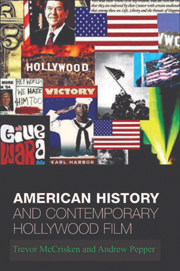Book contents
- Frontmatter
- Contents
- Acknowledgements
- Preface
- Introduction
- 1 Lessons from Hollywood's American Revolution
- 2 Rattling the chains of history: Steven Spielberg's Amistad and ‘telling everyone's story’
- 3 Hollywood's Civil War dilemma: to imagine or unravel the nation?
- 4 Saving the Good War: Hollywood and World War II in the post-Cold War world
- 5 Oliver Stone and the decade of trauma
- 6 From Civil Rights to Black Nationalism: Hollywood v. black America?
- 7 Hollywood's post-Cold War history: the ‘righteousness’ of American interventionism
- Select Bibliography
- Index
4 - Saving the Good War: Hollywood and World War II in the post-Cold War world
Published online by Cambridge University Press: 05 August 2013
- Frontmatter
- Contents
- Acknowledgements
- Preface
- Introduction
- 1 Lessons from Hollywood's American Revolution
- 2 Rattling the chains of history: Steven Spielberg's Amistad and ‘telling everyone's story’
- 3 Hollywood's Civil War dilemma: to imagine or unravel the nation?
- 4 Saving the Good War: Hollywood and World War II in the post-Cold War world
- 5 Oliver Stone and the decade of trauma
- 6 From Civil Rights to Black Nationalism: Hollywood v. black America?
- 7 Hollywood's post-Cold War history: the ‘righteousness’ of American interventionism
- Select Bibliography
- Index
Summary
World War II holds a celebrated position in the benign meta-narrative of American foreign relations. This narrative holds that the United States is a benevolent nation whose foreign policy is based not on pure self-interest but rather on the greater good of all humankind. As H. W. Brands suggests: ‘If a single theme pervades the history of American thinking about the world, it is that the United States has a peculiar obligation to better the lot of humanity… Americans have commonly spoken and acted as though the salvation of the world depended on them.’ According to this meta-narrative, the US has only ever engaged in foreign policy that, while it may have advanced the national interest, also served some higher purpose in the history of human progress: the Spanish–American War was fought to free the Cuban people and others from domination by imperial Spain; World War I was fought to ‘make the world safe for democracy’; World War II was designed to defeat the evils of Nazism and Japanese expansionism whilst establishing the ‘Four Freedoms’ for all peoples; the Cold War was pursued in order to defend the rights of free peoples everywhere against totalitarian aggression and subversion; and the New World Order and more recently the ‘War on Terror’ were established to defend civilised peoples the world over against the uncertainties and dangers of the post-Cold War era.
- Type
- Chapter
- Information
- American History and Contemporary Hollywood Film , pp. 89 - 130Publisher: Edinburgh University PressPrint publication year: 2005

